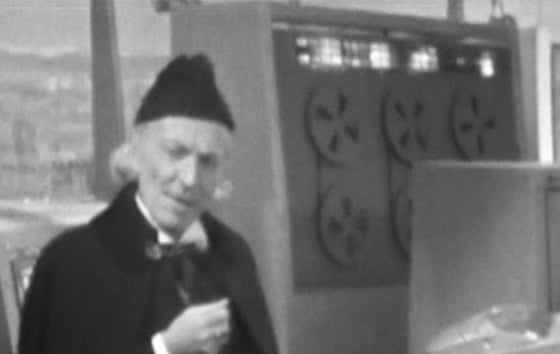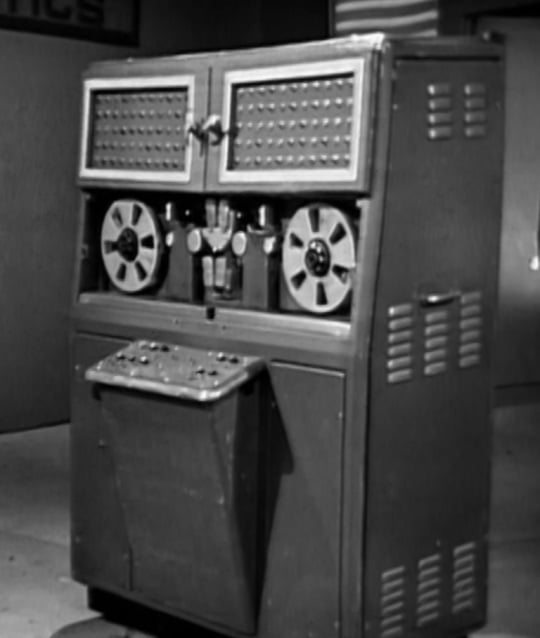Original URL: https://www.theregister.com/2011/11/07/dr_who_verity_stob/
Doctor Who and the Unsatisfactory Five Hole Tape Punch
Early world-dominating computers of the series
Posted in Columnists, 7th November 2011 10:30 GMT
Stob
This sentence is false...
As soon as I heard about the sponsored Doctor Who-themed parties, I just knew that they would want an article on the early years of Doctor Who IT to include in the special pack. However, since nobody has actually asked me for it yet, you get first dibs.
W.O.T.A.N. for Will Operating Thought ANalogue
Manufacture: English Empirical Electrically Actuated Computers Ltd
Store: 1,200 words of 61-bit 'store' as magnetic core memory, multiple reel-to-reel tape drives of an unusual vertical design, dispensing not only with such decorative niceties like pinch rollers and tension loops but also read/write heads.

W.O.T.A.N. Tape Drive
Coding Language: Bedfordshire Autocode II.
Embedded desire to take over the world: Yes.
I/O: Teletype, 110 cps ie, "faster than Polly" (a secretarial/typing pal-to-be of the Doc's). Could do the football results in its spare time. Also has ponderous 0.3 sps (syllable per second) voice output via a speaker. Oh yes, and thought control, achieved via a broadcast signal.
Function: Not a lot. Supposedly the inventor of the "War Machines", creations which are visually the product of the union of a commercial-size chest freezer and Metal Mickey. Unconvincing War Machine appendages included a single, faux tank track in the middle (huh?) and a hammer arm that had a curious, feeble, designed-by-a-child look about it.
Most serious flaw: W.O.T.A.N.'s primitive design led to dreadful continuity errors, notoriously treating the principal character as eponymous.
The Robot Receptionist in the lobby of the International Electromatics building

The Robot Receptionist in the lobby of the International Electromatics building
Manufacture: International Electromatics, possibly from a design by the Cybermen of Telos.
The Cybermen have often been notably successful as innovators in IT. Consider for example, proto-Cyberlord Lumic's use of Bluetooth earpieces as a method of hands-free brainwashing. Particularly impressive given their difficulties handling gold, which disadvantages them in the manufacture of printed circuit boards.
Coding Language: ALGOL
Embedded desire to take over the world: No
Store: It does have a reel-to-reel tape drive, but it seemed to use this as an output device to express frustration, twitching its reels irritably.
I/O: Siri-stylee voice I/O, which proves to be its downfall, as it is inadequately protected against code injection. Zoe dictates a fragment of CyberALGOL:
'BEGIN' 'REAL' X;
SUM(POSITIVE);
DELETE(SQUARE);
'BEGIN'
SUM2[J]
'INTEGER' COMPUTE;
'PRINT' OUT, Y ** -X, VARIABLE, 1;
'GO TO' FINISH;
...
One recognises the style: abandoned, half-finished lines, references to more and more globals, use of uninitialised variables, poor choice of names, gratuitous GOTO breaking the block structure, a sense of prevarication to avoid committing oneself - it's the sort of thing one only usually sees when testing Comp Sci graduates during job interviews.
Naturally an astrophysicist of Zoe's intelligence and culture – remember she is from the futuristic 21st century – would never write this sort of thing, even when, as in this case, she is attempting sabotage. The clever part is that this code fragment, as broadcast by the BBC, represents what the machine hears after its voice recognition processing. No wonder the inline compiler responds by shutting down the machine and setting fire to the tape drive.
Functions: (i) Automatic PBX substitute: handles incoming calls by informing the caller that the requested party is unavailable (ii) Robotic receptionist: handles visitors to the building by denying them access.
Many Doctor Who computers seem unrealistic in their intended purpose or in their execution of their duties; this one perhaps suffers from an excess of dismal realism.
In fact, last year the company introduced the latest version of its core automation package, now with vulnerabilities sorted out, ported to Java, and adapted to the needs of the medical profession. Your dentist uses it. Just last week it sent you an SMS message admonishing you for failing to attend an appointment that you hadn't booked.
B.O.S.S., Bimorphic Organisational Systems Supervisor

Manufacture: British Amalgamated Processing.
Memory: 32 KB semiconductor memory, a disk pack (albeit one that seems to need an alarming amount of switch flicking from the MD to make it go) and the usual reel-to-reel tape decks.
Embedded desire to take over the world: Ho yus.
I/O: Oscilloscope, speech via a speaker, mind control via groovy headphones.
Functions: This is essentially the same machine as W.O.T.A.N. – audio-based mind control – but operated by the private sector instead of the public. This latter point makes a lot of difference. W.O.T.A.N. achieved nothing except the creation of a handful of risible robotic wardrobes, whereas the B.O.S.S. was operating a profitable concern addressing strategic energy requirements. Without the deadly touch of a government IT department, it thrived. If it hadn't been for those pesky U.N.I.T. boys etc.
Serious Flaws: Usual vulnerability to paradoxes, the curse of most pre-1980s computers.
The B.O.S.S., towards the end of its life, went through a curious pretend-Civil Partnership ceremony with its managing director ('my little superman!'), so perhaps its ultimate flaw was that it was too far ahead of its time. The world just wasn't ready for its first gay CPU.
Logopolis
Manufacture: Presumably it evolved, Logopolis being a small, studio-based planet mostly populated by non-speaking extras wielding abacuses.
Huh? What's all this about a planet? I thought this was all about Doctor Who computers? The entities that formed the Logopolitan population together did indeed comprise a computer, and had all the important characteristics of one. They ran subroutines. They were controlled by a Monitor. They never made mistakes.
Memory: Logopolis used non-volatile bubble memory, as was briefly in vogue in the early Earth 1980s. The Logopolitan memory was plug compatible with Earth computers of that period. This turned out to be fortunate as, in the event, the Doctor had forgotten to bring his USB memory stick with him.
Embedded desire to take over the Universe: Nope, because Logopolis in effect already controlled it, by hiving off excess entropy from this universe to other universes. Or something.
Function: Saving the universe as described above by using 'Block Transfer Computation'. This writer has it on the testimony of Logopolis's author, a computer journalist, that this was a reference to the Z80 chip's LDIR instruction (LoaD Indirect Repeat for Zaks' sake, or as the Jargon File more suggestively describes it Computed Block Transfer with increment'). This was a wonderful instruction, that allowed one to move great chunks of memory around in one go, without needing to code up another damn loop. The std::for_each of assembly language.
Serious Flaw: Having reached the point of basing a whole serial on a single machine code instruction, the magic and mystery of computers had pretty much evaporated for the Doctor and his friends, and thereafter the machines tended to be boring and annoying – just like real life. ®
- Stob on The Reg
- Verity Stob book